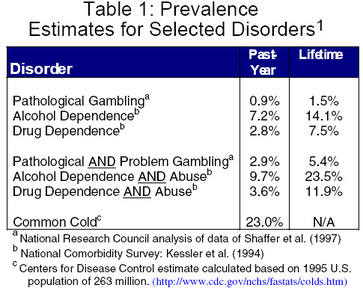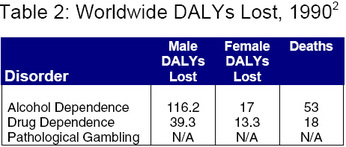Pathological gambling is only one of the over 300 mental disorders listed in Appendix F of DSM-IV. From acute stress disorder to voyeurism, Appendix F provides a comprehensive (there are 31 varieties of bipolar disorder), but probably not exhaustive, catalog of psychiatric diagnoses. And the diagnostic categories are not static; each new edition means additions, deletions, and name changes. For the epidemiologist and layman alike, finding a home for pathological gambling in the spectrum of illness is a daunting task. 
One way to comparatively analyze multiple disorders is to measure distribution. By comparing prevalence estimates, we can get an epidemiological "snapshot" of the degree to which disorders are in the population. It must be remembered that prevalence is not a rate (i.e., does not consider time) and can provide only a static picture of disease distribution. Nevertheless, when compared to alternate measures of disease frequency, prevalence estimates are simpler and less expensive to calculate. Table 1, below, lists prevalence estimates for selected disorders. Pathological gambling has the lowest prevalence of those disorders listed, while the prevalence of the common cold is greater than those of the three addictions combined.

If we were to approach this table with no other health-related knowledge, we might be inclined to conclude that the common cold is a plague of epidemic proportion that inflicts unrivaled suffering on the population. Given the much lower prevalence of pathological gambling, we might similarly conclude that its relative impact on society is negligible. However prevalence does not factor in severity, or the conventional wisdom that considers the common cold to be a mere seasonal nuisance instead of a dreaded disease. Nor do prevalence estimates consider that the common cold lasts a week or two, while an addiction can last a lifetime.
One solution to this dilemma is to count the number of Disability-Adjusted Life Years (DALYs) lost per year for a given disorder. This measure represents the healthy years of life lost annually due to
deaths or disabilities caused by the disorder. When calculating this indicator, epidemiologists use a multivariate formula that takes into account the age of those affected, relative severity of the
disorder, and duration. Table 2 lists the number of DALYs lost in 1990 due to alcohol and drug dependence. While there is no shortage of prevalence estimates for disordered gambling, no DALY-loss estimate is available. Why not? It is true that it is difficult to calculate. And measuring DALY-loss is not necessarily the best or even only method available to epidemiologists interested in measures of disease frequency that take into account multiple factors. To better understand the impact that pathological gambling (and other addictions) have on society, perhaps it is time to move beyond mere prevalence. It is a difficult task, but it is one that may have important consequences for research.
Source: 1Prevalence estimates for all disorders except the common cold: National Research Council. (1999). Pathological gambling: A critical review. Washington, D.C.: National Academy Press. 2The World Bank. (1993). World development report 1993: Investing in Health. Oxford: Oxford University Press.
The WAGER is funded, in part, by the National Center for Responsible Gaming, the Massachusetts Department of Public Health, the Andrews Foundation, the Addiction Technology Transfer Center of New England, the Substance Abuse and Mental Health Administration Services, and the Center for Substance Abuse Treatment.




